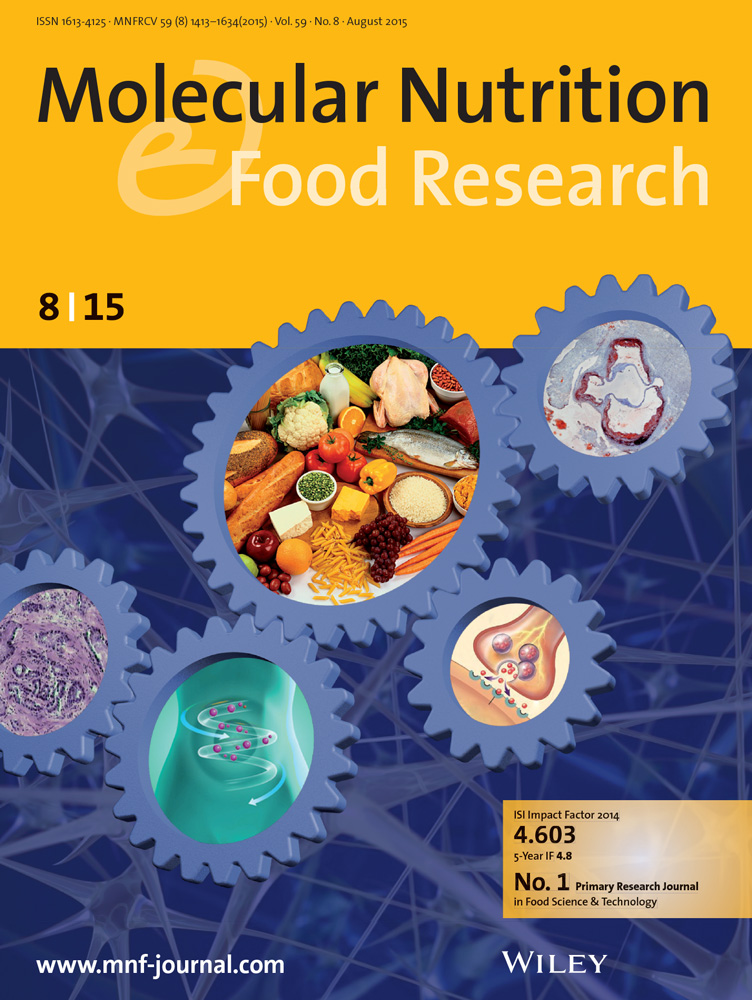综合网络药理学和蛋白质组学揭示萝卜硫素抗皮肤内在衰老的免疫调节机制。
IF 4.2
2区 农林科学
Q1 FOOD SCIENCE & TECHNOLOGY
引用次数: 0
摘要
皮肤老化的特点是结构功能下降,导致与年龄相关的虚弱。萝卜硫素(Sulforaphane, SFN)是一种天然抗炎物质,已广泛应用于多种癌症的治疗中。然而,其在缓解皮肤固有老化中的作用仍有待阐明。综合网络药理学和蛋白质组学研究了SFN在皮肤老化中的潜在机制。发现了51个SFN抗衰老靶点,突出了其对衰老过程的调控作用。根据一个18个月大的自然衰老小鼠模型,补充2个月的SFN后,皮肤结构、氧化还原稳态和免疫细胞组成明显减轻。此外,蛋白质组学分析表明,SFN逆转了内在皮肤衰老的蛋白质组学特征,在SFN喂养的衰老小鼠中发现了233种差异表达蛋白(DEPs)。值得注意的是,上调的dep在apelin信号通路中高度富集(p = 0.010)。此外,免疫细胞浸润和全血细胞分析显示,SFN挽救了真皮组织中T细胞的耗竭,这与SFN激活的apelin信号通路中富集的DEPs密切相关。SFN通过激活apelin信号通路改善皮肤形态和免疫功能,提示对抗皮肤内在衰老的新主要靶点。本文章由计算机程序翻译,如有差异,请以英文原文为准。
Integrative Network Pharmacology and Proteomics Decipher the Immunomodulatory Mechanism of Sulforaphane Against Intrinsic Skin Aging.
Skin aging is characterized by declines in structural functions, contributing to age-associated frailty. Sulforaphane (SFN), a natural anti-inflammatory substance, has been widely applied in multiple types of cancer therapies. However, its role in alleviating intrinsic skin aging remains to be elucidated. Integrative network pharmacology and proteomics were utilized to investigate the underlying mechanisms of SFN in intrinsic skin aging. Fifty-one anti-aging targets of SFN were identified, highlighting its promising regulatory impact on the aging process. Based on an 18-month-old natural aging mouse model, significant alleviation in skin structure, redox homeostasis, and immune cell composition was noted after 2 months of SFN supplementation. Additionally, proteomic analysis demonstrated that SFN reversed the proteomic profile of intrinsic skin aging, with 233 differentially expressed proteins (DEPs) identified in SFN-fed aging mice. Of note, the up-regulated DEPs were highly enriched in the apelin signaling pathway (p = 0.010). Furthermore, immune cell infiltration and whole blood cell analysis revealed that SFN rescued T cells depletion in dermal tissue, which was strongly correlated with DEPs enriched in the SFN-activated apelin signaling pathway. SFN improves skin morphology and immune functions via activating the apelin signaling pathway, suggesting new prime targets in counteracting intrinsic skin aging.
求助全文
通过发布文献求助,成功后即可免费获取论文全文。
去求助
来源期刊

Molecular Nutrition & Food Research
工程技术-食品科技
CiteScore
8.70
自引率
1.90%
发文量
250
审稿时长
1.7 months
期刊介绍:
Molecular Nutrition & Food Research is a primary research journal devoted to health, safety and all aspects of molecular nutrition such as nutritional biochemistry, nutrigenomics and metabolomics aiming to link the information arising from related disciplines:
Bioactivity: Nutritional and medical effects of food constituents including bioavailability and kinetics.
Immunology: Understanding the interactions of food and the immune system.
Microbiology: Food spoilage, food pathogens, chemical and physical approaches of fermented foods and novel microbial processes.
Chemistry: Isolation and analysis of bioactive food ingredients while considering environmental aspects.
 求助内容:
求助内容: 应助结果提醒方式:
应助结果提醒方式:


